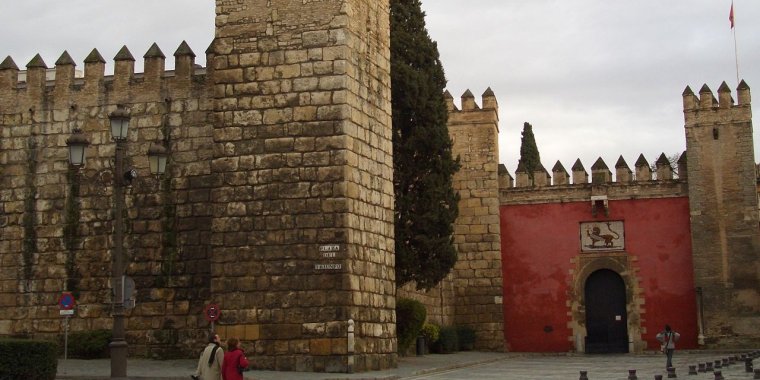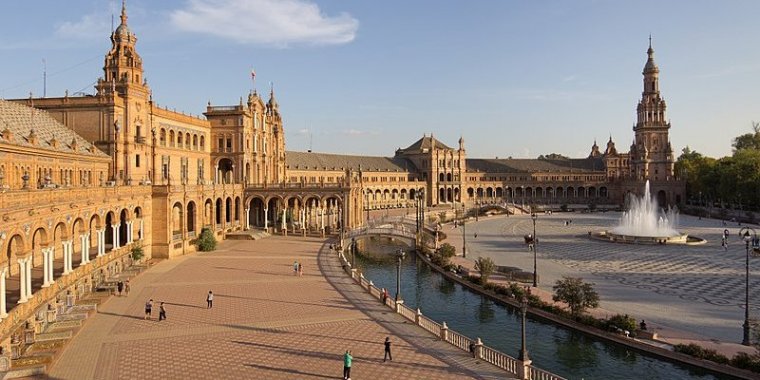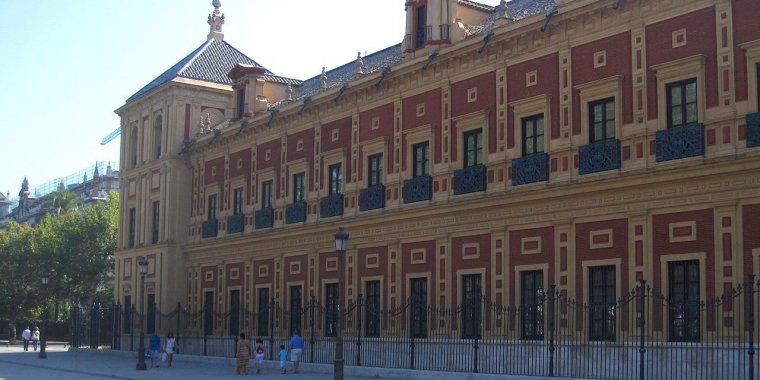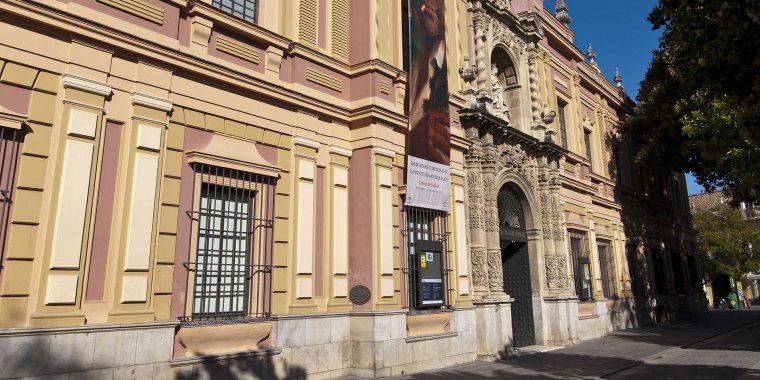| Published in Attractions / Places of Interest |
Tourist Attractions in Seville, Spain
Seville is the capital and largest city of the autonomous community of Andalusia and the province of Seville, Spain. It is situated on the plain of the river Guadalquivir. The inhabitants of the city are known as sevillanos (feminine form: sevillanas) or hispalenses, after the Roman name of the city, Hispalis.
• Cathedral of Seville (Catedral de Sevilla), Avenida de la Constitución. Jul-Aug M 09:30-14:30, Tu-Sa 09:30-14:00, Su 14:30-18:00; Sep-Jun M 11:00-15:30, Tu-Sa 11:00-17:00, Su 14:30-18:00. Once judged the third largest church in the world after Saint Peter's in Rome and Saint Paul's in London, this is now the largest church in the world by volume.
The 15th-century cathedral occupies the site of the former great mosque built in the late twelfth century. The central nave rises to an awesome 37 m over a total area of 11,520 m². The cathedral is the final resting place of the remains of Christopher Columbus. Buy tickets at the nearby Church of Salvador (Iglesia del Salvador), where you can buy the tickets for Salvador and Cathedral+Giralda. You will save yourself the long queues and visit another amazing church. €8 (adults), €4 (seniors/youth under 25), free (residents).
• La Giralda. A large and beautiful minaret tower built for the chief mosque, it is now the magnificent bell tower of the cathedral and a symbol of Seville. Climb the 34 ramps for a great view of the city. Admission included with entry for cathedral.
• Real Alcázar, Plaza del Triunfo (entrance). Apr-Sep daily 09:30-19:00, Oct-Mar daily 09:30-17:00. A beautiful palace in Mudéjar (Moorish) style, built in the 14th century by Pedro I the Cruel. With its myriad rooms, extravagant architecture, lavish gardens with many courtyards, ponds and secrets to be explored, it is a fascinating place to visit.
Be sure to check out the room where Christopher Columbus's journey to the Americas were planned. You can see his coat of arms embroidered on the wall along with many other royals. In the heat of summer it offers a cool retreat from the suns glare and can quite easily keep you occupied for a few centuries, if not all of your life. During high season it is advisable to make reservations in advance; tickets can be purchased online. €9.50 (adults), €2 (seniors/students 17-25), free (disabled/residents/children under 16).
• Royal Apartments (Palacio Real Alto). Tours daily every half-hour from 10:00-13:30. Still used by the royal family on official visits and open to tours when not in use. €4.50.
• Palacio de Las Dueñas (Las Duenas Palace), Calle Dueñas 5 (in the Historical Center near Las Setas). Apr-Sep: M-Sa 10:00-20:00; Oct-Mar: M-Sa 10:00-18:00. Las Dueñas is a palace belonging to the House of Alba. It was built in the 15th century, with Renaissance architecture style and Gothic-Mudejar influences. The palace is one of the major historic homes in the city. The poet Antonio Machado was born here in 1875. It is also said that Amerigo Vespucci married in this chapel at the beginning of the 16th century.
The Palace has a great collection of paintings (Ribera, Luca Giordano, Neri de Bicci), ceramics, antique furniture and other decorative arts, sculptures of Ancient Rome and contemporary (Mariano Benlluire), Flemish tapestries (Willem de Pannemaker), mosaics, and many other pieces of art. An important site for understanding Andalusian customs and history. Fee: €10 with audio guide, ask for reduced prices.
• Hospital de los Venerables (Diego Velázquez Research Centre), Plaza de los Venerables 8 (in the Barrio Santa Cruz), M-F 10:00-14:00, 16:00-20:00. A 17th-century retirement home and hospital for aged and sickly retired priests, restored by the Fundación to preserve an example of Andalusian architecture at its very best. Includes a resplendent Baroque chapel which is highly recommended, as well as the Santa Rufina painted by Diego Velázquez. €4.75 with audio guide.
• Barrio Santa Cruz (Jewish Quarter) (around the cathedral). Filled with small, winding streets and is generally regarded as the most charming part of the city, but it is also fairly touristy.
• Torre del Oro (Tower of Gold), Paseo de Cristóbal Colón, Sa Su 10:30-18:45; holidays closed. A 13th-century tower, the top of which is rumored to have once been covered in gold. It now houses the local maritime museum. €3 (adults), €1.50 (seniors/students/children 6-14), free (children under 6); €2 for audioguide.
• Plaza de España. The site of the Spanish pavilion from the 1929 exhibition. It was also used in the filming of the new Star Wars episodes. It is somewhat in need of repair. Visit it early in the morning on a weekday to see a long line of immigrants outside one of the government offices it now houses, or visit it right before it closes (officially at 22:00 but likely half an hour later) to see it completely empty and rather eerie.
• Real Fábrica de Tabacos (Universidad de Sevilla), Calle San Fernando, 4. During term time only: M-F 10:00-20:00, Sa 10:00-14:00. The main building of the University of Seville was once the Tobacco Factory of Seville, and was constructed between 1728 and 1771 by Sebastián Van der Bocht. Over the main entrance, the triangular façade ends in a statue of La Fama (fame).
The tobacco factory was then the largest industrial building in Spain. A monopoly assured high income, which is reflected in the factory's architecture and surrounding gardens. Its chapel and prison complement the main building. In the interior you find impressive stairways, fountains and Patios. It was the setting for the first act of Bizet's opera Carmen. In 1953 the factory was converted into the main building of Seville University. Just behind the tobacco factory, the María Luisa Park borders the historic center of Seville to the south. Free.
• Palacio de la Condesa de Lebrija (Palace of the Countess of Lebrija), Calle Cuna, 8. M-F 10:30-19:30 (Jul Aug 09:00-15:00), Sa 10:00-19:00 (Jul Aug 10:00-14:00), Su 10:00-14:00 (Jul-Aug closed). The palace is considered the 'best paved house-palace in Europe' owing to its collection of Roman mosaics, which paved practically the whole of the ground floor. There is also a collection of well parapets, vases, amphora, columns and sculptures of incalculable worth.
On the upper floor you can visit the residences previously inhabited by the Countess and her descendants, up to only a few years ago; extremely well-preserved, they are today filled with ornaments and furniture from all over the world, priceless artwork by Van Dyke, Bruegel, Alonso Cano, among others, as well as collections of porcelain and glass. €5 (ground floor only), €8 (both floors).
• Casa de Pilatos, Plaza de Pilatos, 1, e-mail: casapilatos@fundacionmedinaceli.org. Nov-Mar daily 09:00-18:00, Apr-Oct daily 09:00-19:00. A 16th-century palace and generally thought to be one of the best in the city. €8; free on Mondays after 13:00.
• Palacio Arzobispal (Archbishop's Palace), Plaza Virgen de los Reyes. It is in the historical section of the city and is home to various clergy and the Archbishop. On the outside you only can catch a glimpse of the patio but on the inside there are important works of art. Free.
• Archivo General de Indias (General Archive of the Indies), Avenida de la Constitución, 3. 16 Sep – 15 Jun: M-F 08:00-15:00; 16 Jun – 15 Sep: M-F 08:00-14:30. This Renaissance building houses extensive archives relating to the Spanish conquest of the Americas, and is designated a UNESCO World Heritage Site. Included in the collection are the diaries of Columbus. The archive hosts rotating special exhibits. Free.
• Metropol Parasol, Plaza de la Encarnación (bus 27/32, metro T1). Su-Th 10:30-24:00, F Sa 10:30-01:00. A enormous wooden structure designed by German architect Jürgen Mayer-Hermann, inspired by the Cathedral of Seville and in the form of giant mushrooms. Known to locals as 'las setas' (the mushrooms), the structure covers the Central Market and the Antiquarium; the top level contains a restaurant and provides some of the best views of Seville. €3, free (children under 12/disabled/Seville residents).
• The City Hall was built in the 16th century in high Plateresque style by master architect Diego de Riaño. The façade to Plaza Nueva was built in the 19th century in Neoclassical style.
• The Palacio de San Telmo, formerly the University of Sailors, and later the Seminary, is now the seat for the Andalusian Autonomous Government. It is one of the most emblematic buildings of baroque architecture, mainly to its world-renowned churrigueresque principal façade and the impressive chapel.
• The Castillo de San Jorge (Castle of St. George) is situated near the Triana market, next to the Isabel II bridge. It was the last seat for the Spanish Inquisition.
Museums and Galleries
• Museo de Bellas Artes, Plaza del Museo, 9, e-mail: museobellasartessevilla.ccd@juntadeandalucia.es. 16 Sep – 31 May: Tu-Sa 10:00-20:30, Su and holidays 10:00-17:00; 1 Jun – 15 Sep: Tu-Sa 09:00-15:30, Su and holidays 10:00-17:00. Considered by some as the second most important fine arts museum in Spain after the Prado in Madrid. The museum building is a former mercy convent renewed in the 17th century and the fifteen exhibition rooms show a comprehensive picture of Sevillian art from the Gothic period to the early trends of the 20th century. The square just outside hosts an open-air art market on Sundays until around 13:30. Plenty of original paintings on local topics, although some not so interesting bits as well! €1.50; free for EU citizens.
• Museo de Carruajes, Plaza de Cuba, 10. 1 Sep – 15 Jun: M-Th 09:00-14:00 17:00-19:30, F 09:00-14:00; 16 Jun – 31 Aug: M-F 09:00-14:00. A small museum with carriages of various kinds. €3.60 (adults), €2.60 (children/students/seniors), free (EU citizens); free admission on Tuesdays.
• Museo Arqueológico de Sevilla (Seville Archeology Museum), Plaza de América. 16 Sep – 31 May: Tu-Sa 10:00-20:30, Su and holidays 10:00-17:00; 1 Jun – 15 Sep: Tu-Sa 09:00-15:30, Su and holidays 10:00-17:00. It has one of the best collection of Roman-era artifacts in Spain, brought from nearby Italica. €1.50; free for EU citizens.

Museo Arqueológico de Sevilla. ![]()
• Museo Antiquarium, Plaza de la Encarnación (underground level of the Metropol Parasol). Daily 11:00-14:00, 15:00-20:00. A museum with excavated Roman and Moorish remains, discovered during construction of the Metropol Parasol.
• The Museum of Arts and Traditions, also in América Square, in front of the Archaeological museum.
• La Casa de la Ciencia de Sevilla (Science Museum), opposite the María Luisa Park.
Flamenco
Flamenco is very popular in Spain and is not just for tourists; however finding the right place is hard. Poke around the neighbourhood of El Arenal, following the sounds of flamenco music to find a place.
• Museo del Baile Flamenco, Calle de Manuel Rojas Marcos, 3. Daily 10:00-19:00 (museum), performances 19:00-20:00. Offers an experience for all the senses with ambiental music, videos, touch-screens and artifacts to be found in this 18th century building at the heart of the historical Barrio Santa Cruz. On Friday and Saturday evenings a spectacular show is hosted at a discounted price for visitors to the museum. Flamenco art and photography exhibitions are also on display and dance, singing, percussion and guitar lessons are offered. Museum: €10/8/6 (adults/seniors/children); performances: €20/14/12 (adults/seniors/children).
• La Casa del Flamenco (Cultural Centre), Calle Ximénez de Enciso, 28. Daily autumn/winter 19:30, spring/summer 21:00. A good spot to see real flamenco. €18.
• La Carbonería, Calle Levíes, 18 (near the cathedral). 21:30, 22:30, and 23:30 daily. Offers free flamenco shows nightly. Arrive early for good seats.
Festivals
• Semana Santa. The sombre Easter week processions feature thousands of people and go on all week, a spectacular display of conspicuous Catholicism.
• Feria de Abril (Seville Fair). Also known as "Feria de Sevilla" - a release after the somberness of Semana Santa. To say this is a huge party would be an understatement. Most if not all of Seville takes a week's holiday and they plan for the fair months in advance. The fair is close to the river. It covers a huge area and contains hundreds of private and public casetas which are laid out to form streets. Casetas are small marquees and you can only get into the private ones if invited. The public ones are large but just as much fun.
The day is naturally split in two and between noon and 20:00 the streets of the fair throng with horses as riders and carriages strut their stuff dressed in traditional Spanish robes. After 20:00 the streets are cleared and "Calle del Inferno" comes to life. This must be one of the best funfairs in Europe – it takes weeks to assemble and pack up. Experience traditional dress, flamenco dancing (and the "sevillanas", the traditional dance of the region of Seville), guitars, fino, great tapas and participants who dance with gusto and eat and drink the day and night away.
Parks and Gardens
• The Parque de María Luisa (María Luisa Park), is a monumental park built for the 1929 World's Fair held in Seville, the Exposición Ibero-Americana. The so-called Jardines de las Delicias (literally, Delighting Gardens), closer to the river, are part of the Parque de María Luisa.
• The Alcázar Gardens, within the grounds of the Alcázar palace, consist of several sectors developed in different historical styles.

Jardines de los Reales Alcázares. ![]()
• The Gardens of Murillo and the Gardens of Catalina de Ribera, both along and outside the South wall of the Alcázar, lie next to the Santa Cruz quarter.
• The Parque del Alamillo y San Jerónimo, the largest park in Andalusia, was originally built for Seville Expo '92 to reproduce the Andalusian native flora. It lines both Guadalquivir shores around the San Jerónimo meander.
• The 32-metres-high bronze sculpture, The Birth of a New Man (popularly known as Columbus's Egg, el Huevo de Colón), by the Georgian sculptor Zurab Tsereteli, is located in its northwestern sector.
• The American Garden, also completed for Expo '92, is in La Cartuja. It is a public botanical garden, with a representative collection of American plants donated by different countries on the occasion of the world exposition. Despite its extraordinary botanical value, it remains a mostly abandoned place. (Wikivoyage, Wikipedia)
See also Seville in Pictures.
YOU MAY ALSO LIKE
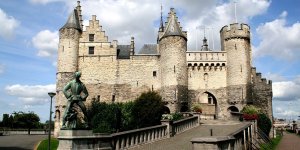
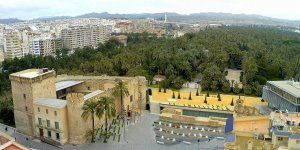

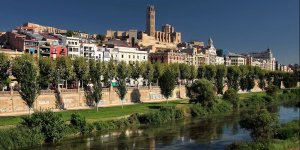


 If you own or manage a travel-related business such as a hotel, a bed-and-breakfast, a restaurant, a pub or a cafeteria, you can create a web page for your business for free on Titi Tudorancea Travel Info. » |



